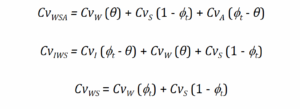Exercise 4 – Changing Thermal Properties of Peat as it Thaws
As a peat profile thaws, it changes state from being:
-
saturated and frozen; to
-
saturated and unfrozen; and then to
-
unsaturated and unfrozen (in other words, the soil thaws, then drains).
- The volumetric heat capacity (J m-3 C-1) is the quantity of heat needed to raise the temperature of a unit volume of soil. Compute the values of the volumetric heat capacity of a peat soil for each of these three stages using the appropriate choice from the following equations.


Assume the soil profile is entirely peat. The results of Hayashi and others (2007) suggest the liquid soil moisture content for frozen soil is in the range of 0.15 to 0.2 (assume 0.2 for this case) and the drained water content is 0.5. For each constituent, the values of specific heat, cp (J kg-1 C-1), mass density, ρ (kg m-3), porosity, 𝜙t (-), and thermal conductivity, kt (W m-1 ℃-1) are given in following table. Volumetric heat capacity is the product of specific heat capacity and density

2. How would the transition from one condition to the next affect temperatures within the peat profile? What factors might effect the rate of transition from one condition to the next, and therefore the rate of temperature increases in the peat profile? For those who have access to commercial publications of the Wiley publishing house, Hayashi and others (2007) provides a thorough discussion of this topic.
3. Another important thermal property of porous media is its thermal conductivity (W m-1 ℃-1), defined as the amount of heat transferred through a unit area per unit time under a unit temperature gradient. Considering the very large difference in thermal conductivity values presented in the table above, describe how the transition from one compositional stage to the next effects the rate of ground thaw.
